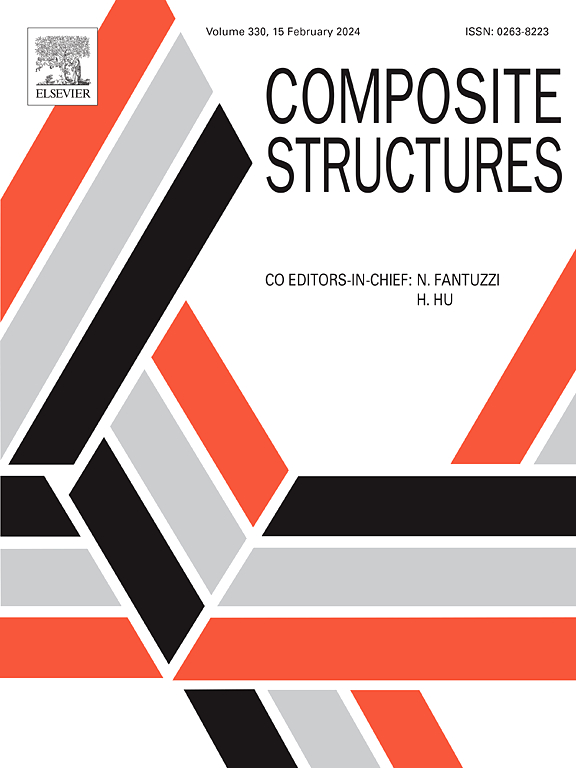散热异质结构的综合应力驱动多材料问题
IF 6.3
2区 材料科学
Q1 MATERIALS SCIENCE, COMPOSITES
引用次数: 0
摘要
在热弹性结构设计领域,特别是在航空航天和更广泛的工程领域,异质材料的多样化行为以及热机械耦合考虑中基于应力系统的复杂要求带来了复杂的挑战。本研究通过提出一种综合方法来应对这些挑战,该方法有两个主要贡献:(i) 为解决散热问题的应力驱动设计开发了一种有效的统一解决方案,该方案适用于从同质到异质的各种材料;(ii) 为耦合热机械系统中的多材料问题引入了一种稳健的基于应力的优化方法。该方法采用成熟的 P 准则方法,将异质应力整合为统一的全局度量。此外,它还将有效材料插值与广义各向同性固体材料与惩罚(SIMP)框架进行了整合,从而建立了包括构成矩阵、热导率、热应力系数和热弹性应力分布在内的综合多材料模型。为了进一步提高适应性和灵活性,该方法采用了多边形离散技术。利用邻接变量技术进行了详细的敏感性分析,以提高基于梯度的数学编程算法的计算效率。通过数值实例验证了所提方法的效率、稳健性和实用性,证明了其在实际应用中的有效性和可靠性。本文章由计算机程序翻译,如有差异,请以英文原文为准。
Comprehensive stress-driven multi-material problem for heat-sinking heterogeneous structures
In the realm of designing thermoelastic structures, particularly within aerospace and broader engineering fields, complex challenges arise from the diverse behaviors of heterogeneous materials and the intricate requirements of stress-based systems in coupled thermomechanical considerations. This study addresses these challenges by proposing a comprehensive methodology with two main contributions: (i) the development of an effective unified solution for stress-driven designs that tackle heat-sinking problems by accommodating a wide range of materials, from homogeneous to heterogeneous and (ii) the introduction of a robust stress-based optimization approach for multi-material problems within coupled thermomechanical systems. The methodology employs the well-established -norm approach to consolidate heterogeneous stresses into a unified global metric. Additionally, it integrates effective material interpolation with the generalized Solid Isotropic Material with Penalization (SIMP) framework, resulting in comprehensive multi-material models that include the constitutive matrix, thermal conductivity, thermal stress coefficient, and thermoelastic stress distributions. To further enhance adaptability and flexibility, the methodology incorporates a polygonal discretization technique. Detailed sensitivity analyses, using the adjoint variable technique, are conducted to improve computational efficiency in gradient-based mathematical programming algorithms. The efficiency, robustness, and practicality of the proposed methodology are validated through numerical examples, demonstrating its effectiveness and reliability in real-world applications.
求助全文
通过发布文献求助,成功后即可免费获取论文全文。
去求助
来源期刊

Composite Structures
工程技术-材料科学:复合
CiteScore
12.00
自引率
12.70%
发文量
1246
审稿时长
78 days
期刊介绍:
The past few decades have seen outstanding advances in the use of composite materials in structural applications. There can be little doubt that, within engineering circles, composites have revolutionised traditional design concepts and made possible an unparalleled range of new and exciting possibilities as viable materials for construction. Composite Structures, an International Journal, disseminates knowledge between users, manufacturers, designers and researchers involved in structures or structural components manufactured using composite materials.
The journal publishes papers which contribute to knowledge in the use of composite materials in engineering structures. Papers deal with design, research and development studies, experimental investigations, theoretical analysis and fabrication techniques relevant to the application of composites in load-bearing components for assemblies, ranging from individual components such as plates and shells to complete composite structures.
 求助内容:
求助内容: 应助结果提醒方式:
应助结果提醒方式:


